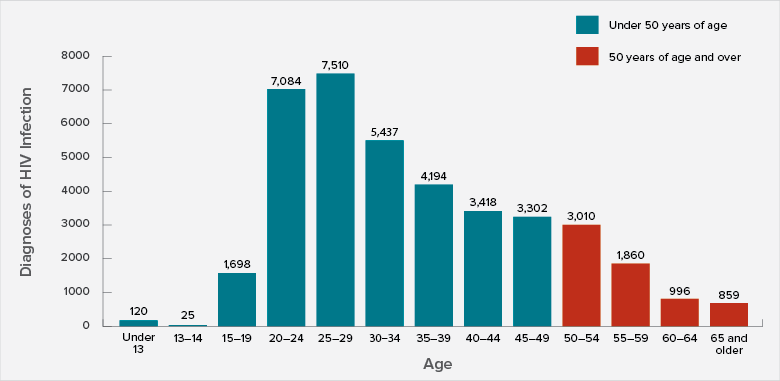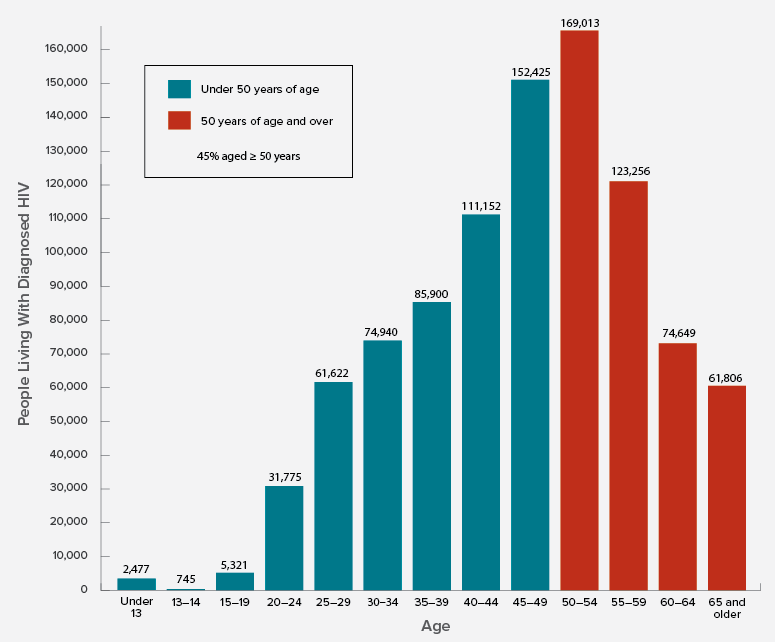HIV Among People Aged 50 and Over
Fast Facts
- Thanks to better treatments, people with HIV are living longer. People aged 50 and over account for an estimated 45% of Americans living with diagnosed HIV.
- People aged 50 and older have the same HIV risk factors as younger people, but may be less aware of their HIV risk factors.
- Older Americans are more likely to receive a diagnosis of HIV infection later in the course of their disease.

At the end of 2014, an estimated 428,724 people aged 50 and over were living with diagnosed HIV in the United States.
The Numbers
HIV Incidencea
- Annual HIV infections among gay and bisexual menb aged 55 and over increased 18% from 2010 to 2014 (from 1,100 to 1,300).
HIV Diagnosesc
- People aged 50 and over accounted for 17% (6,725) of the 39,513 HIV diagnoses in 2015 in the United States. People aged 50 to 54 accounted for 45% (3,010) of the diagnoses among people aged 50 and over.d
- Among people aged 50 and over, blacks/African Americans accounted for 43% of all new HIV diagnoses in 2015. Whites accounted for 36%, and Hispanics/Latinose accounted for 17%.
- Among people aged 50 and older, 49% of new HIV diagnoses in 2015 were among gay and bisexual men, 15% were among heterosexual men, 23% were among heterosexual women, and 12% were among persons who inject drugs.f
- From 2010 to 2014, HIV diagnoses among all people aged 50 and over decreased by 10%.
- In 2014, 40% of people aged 55 and older had late stage infection (AIDS) at the time of HIV diagnosis (i.e., diagnosed late in the course of the infection).
HIV Diagnoses by Age, 2015, United States

Source: CDC. Diagnoses of HIV infection in the United States and dependent areas, 2015. HIV Surveillance Report 2015;27.
Living With HIV and Deaths
- In 2014, an estimated 45% of Americans living with diagnosed HIV were aged 50 and older, 27% were aged 55 and older, and 6% were aged 65 and older.
- Among all people aged 55 and older living with HIV in 2014, 93% had received a diagnosis, 67% received HIV medical care, 55% received continuous HIV care, and 57% had a suppressed viral load.g By comparison, 85% of all people living with HIV had received a diagnosis, and 49% had a suppressed viral load. A person with a suppressed viral load can stay healthy and has a dramatically reduced risk of transmitting HIV to others.
- Of the 6,721 deaths from HIV in 2014, 2,610 (39%) were among people aged 55 and older.
People Living With Diagnosed HIV by Age, 2014, United States

Source: CDC. Diagnoses of HIV infection in the United States and dependent areas, 2015. HIV Surveillance Report 2015;27.
Prevention Challenges
Older people in the United States are more likely than younger people to have late stage HIV infection at the time of diagnosis, which means they start treatment late and possibly suffer more immune-system damage. Late diagnoses can occur because health care providers may not always test older people for HIV infection. Also, older people may not consider themselves to be at risk of HIV infection or may mistake HIV symptoms for those of normal aging and not consider HIV as a cause.
Many older people are sexually active, including those living with HIV, and may have the same HIV risk factors as younger people, including a lack of knowledge about HIV prevention, as well as having multiple sex partners. Older people also face some unique issues:
- Many widowed and divorced people are dating again. They may be less aware of their risks for HIV than younger people, believing HIV is not an issue for older people. Thus, they may be less likely to protect themselves.
- Women who no longer worry about becoming pregnant may be less likely to use a condom and to practice safer sex. Age-related thinning and dryness of vaginal tissue may raise older women’s risk for HIV infection.
- Although they visit their doctors more frequently, older people are less likely than younger people to discuss their sexual habits or drug use with their doctors. And doctors are less likely to ask their older patients about these issues.
Stigma is a particular concern among older people because they may already face isolation due to illness or loss of family and friends. Stigma negatively affects people’s quality of life, self-image, and behaviors, and may prevent them from seeking HIV care and disclosing their HIV status.
Aging with HIV infection also presents special challenges for preventing other diseases because both age and HIV increase risk for cardiovascular disease, bone loss, and certain cancers. Older HIV patients and their care providers need to maximize prevention efforts against these conditions and remain vigilant for early signs of illness. They also need to be careful about interactions between the medications used to treat HIV and those used to treat common age-related conditions such as hypertension, diabetes, elevated cholesterol, and obesity.
What CDC Is Doing

CDC and its partners are working together to maximize the effectiveness of current HIV prevention methods and improve surveillance among all people in the United States. For example,
- Under the current funding opportunity, CDC has awarded at least $330 million each year to health departments to direct resources to the populations and geographic areas of greatest need and prioritize the HIV prevention strategies that will have the greatest impact.
- CDC provides support and technical assistance to health departments and community-based organizations to deliver effective prevention and evidence-based interventions for antiretroviral therapy adherence for older Americans.
- CDC is awarding approximately $130 million over 5 years (2014-2019) to provide training and technical assistance for staff of health departments, community-based organizations, and health care organizations to help them link HIV-positive people to care, retain or reengage them in care, and help them achieve viral suppression.
- Act Against AIDS, a national communications initiative, focuses on raising awareness, fighting stigma, and reducing the risk of HIV infection among at-risk populations. Act Against AIDS includes Let’s Stop HIV Together (approximately 25% of campaign participants are aged 50 and older); HIV Screening. Standard Care., which encourages primary care physicians to screen patients of all ages for HIV infection; Prevention IS Care, which provides continuing education and materials for physicians to address the complex issues of those living with HIV infection; HIV Treatment Works, which shows how people living with HIV have overcome barriers to get in care and stay on treatment, and Start Talking. Stop HIV., which encourages gay and bisexual men to have conversations about safer sex.
For additional information and resources, visit:
- Administration on Aging
- National Institutes of Health
- Services & Advocacy for LGBT Elders
- HIV and Older Adults
aEstimated annual HIV infections are the estimated number of new infections (HIV incidence) that occurred in a particular year, regardless of when those infections were diagnosed.
b The term male-to-male sexual contact is used in CDC surveillance systems. It indicates a behavior that transmits HIV infection, not how individuals self-identify in terms of their sexuality. This fact sheet uses the term gay and bisexual men.
c HIV diagnoses indicate when a person was diagnosed with HIV, not when the person was infected.
d Data for 2015 are preliminary (subject to change) because they are based on only a 6-month reporting delay. Data for 2015 should not be used when assessing trends.
e Hispanics/Latinos can be of any race.
f Persons who inject drugs include infections attributed to injection drug use and those attributed to male-to-male sexual contact and injection drug use.
gViral suppression is defined as having fewer than 200 copies of the virus per milliliter of blood on the most recent viral load test in 2014. Receiving continuous HIV care is defined as having two viral load or CD4 tests 3 or more months apart in 2014. (CD4 cells are the cells in the body’s immune system that are destroyed by HIV.)
Bibliography
- Monitoring selected national HIV prevention and care objectives by using HIV surveillance data—United States and 6 dependent areas—2015. HIV Surveillance Supplemental Report 2017;22(2). Accessed September 14, 2017.
- Diagnoses of HIV infection among adults aged 50 years and older in the United States and dependent areas, 2010-2014. HIV Surveillance Supplemental Report 2016;21(2). Accessed September 14, 2017.
- Althoff KN, Gebo KA, Gange SJ, et al. CD4 count at presentation for HIV care in the United States and Canada: Are those over 50 years more likely to have a delayed presentation? AIDS Res Ther 2010;7:45.
- Brooks JT, Buchacz K, Gebo KA, Mermin J. HIV infection and older Americans: the public health perspective. Am J Public Health 2012;102(8):1516-26.
- National Institute on Aging. HIV, AIDS, and older people. Bethesda, MD: National Institutes of Health; 2016. Accessed September 14, 2017.
- Lindau ST, Schumm LP, Laumann EO, Levinson W, O’Muircheartaigh CA, Waite LJ. A study of sexuality and health among older adults in the United States. N Engl J Med 2007;357(8):762-74.
- Onen NF, Shacham E, Stamm KE, Overton ET. Comparisons of sexual behaviors and STD prevalence among older and younger individuals with HIV infection. AIDS Care 2010;22(6):711-17. PubMed abstract.
- Foster PP, Gaskins SW. Older African Americans’ management of HIV/AIDS stigma. AIDS Care 2009;21(10):1306-12. PubMed abstract.
- Golub SA, Tomassilli JC, Pantalone DW, Brennan M, Karpiak SE, Parsons JT. Prevalence and correlates of sexual behavior and risk management among HIV-positive adults over 50. Sex Transm Dis 2010;37(10):615-20. PubMed abstract.
- Emlet CA. “You’re awfully old to have this disease”: experiences of stigma and ageism in adults 50 years and older living with HIV/AIDS. Gerontologist 2006;46(6):781-90.
- Glaude-Hosch JA, Smith ML, Heckman TG, Miles TP, Olubajo BA, Ory MG. Sexual behaviors, healthcare interactions, and HIV-related perceptions among adults age 60 years and older: an investigation by race/ethnicity. Curr HIV Res 2015;13(5):359-68. PubMed abstract.
Additional Resources
- CDC-INFO 1-800-CDC-INFO (232-4636)
- CDC HIV Website
- CDC Act Against AIDS Campaign
- CDC HIV Risk Reduction Tool (BETA)
- Page last reviewed: September 15, 2017
- Page last updated: September 21, 2017
- Content source: Division of HIV/AIDS Prevention, National Center for HIV/AIDS, Viral Hepatitis, STD, and TB Prevention, Centers for Disease Control and Prevention


 ShareCompartir
ShareCompartir